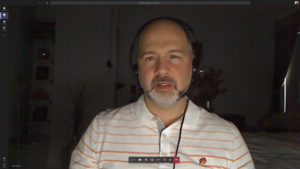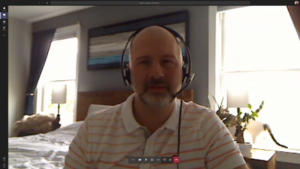With millions of people working from home today, video conferencing has grown in importance for workplace communication. However, if you had not previously considered a work-from-home scenario, you may need to optimize your home conferencing space – and fast.
Besides having a device with a good camera, light is the primary factor in your video quality. With a few considerations and adjustments, you can create a space using what’s available in your home to facilitate good video conferencing. Here are a few tips complied from a conversation with The Lighting Practice’s Jered Widmer, Johnathan Cook, and Sean Cassidy.
Integrate Daylight When Possible
Using daylight correctly will allow your camera to render more realistic color on your face and provide a more flattering light for your video. Position yourself facing windows to use natural light as your foreground light. You may need to adjust the intensity of the light coming from your windows. Draw sheer curtains or re-orient window blinds to soften how light enters the room without eliminating it.
If daylight is positioned behind you and unavoidably in the camera’s view, try cropping those bright windows or doorways out of your camera’s shot. Jered Widmer, Principal of TLP, suggests moving your device closer to you, maximizing your body and face on the screen in order to reduce what the camera sees around you. Digital cameras try to balance the picture with the brightest and darkest parts of the image. Cropping bright light sources like a window or lamp out of the picture will help your camera focus on the brightness of your face.
Bonus Tip: Daylight supports the circadian rhythm. Choosing a daylit room as your workspace may help keep you alert and energized during the day.
If your space does not have enough daylight, you can supplement the available natural light using strategically placed electric light.
Position Light Correctly
Whether you are in a daylight-filled room or a dark space, layers of light are key. The position of each light source will impact your image. To get started, there should be light in front of you (besides the light coming from your computer screen). The light should be diffused – rather than a spotlight – to softly illuminate your face.
Try one of the following:
- Position yourself to face a window (the most ideal scenario).
- Place a table or floor lamp with a shade in front of you.
- Aim a bright, unshaded electric light at a nearby wall in front of you to get a soft reflection of light on your face.
If you are using an electric light source in front of you, TLP Designer, Sean Cassidy, suggests positioning the light at an angle to show more dimension on your face. He recommends aiming the light slightly on your “better side” or more prominent side and angling it away from the computer for a soft glow.
The second layer of light should be additional light sources behind you to create a balance in the room. The goal is to have the brightness of your background similar to that of your foreground (your face), to help prevent your face from being overexposed (too bright) or backlit (in shadow). TLP Project Manager, Johnathan Cook, offers this rule of thumb: in addition to the light in front of you, reduce unwanted contrast by adding background light and “fill” light, meaning general ambient light in the room. An overhead light can be overpowering, so consider dimming it or turning it off and relying on floor and table lamps to create an even brightness.
Set Up Your Space Before Your Video Call
Getting the lighting right for video conferencing in your space will likely require some trial and error. Give yourself five to 10 minutes before your call to turn on your camera, follow the tips above, and adjust your light sources.









